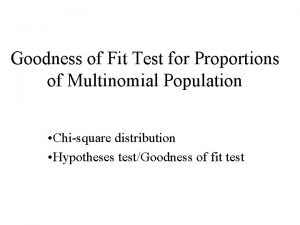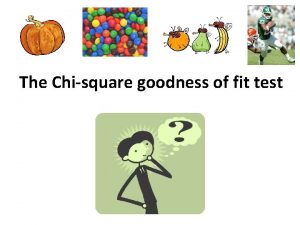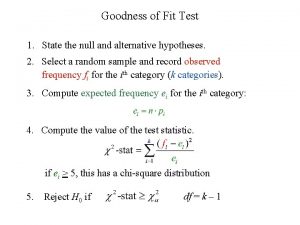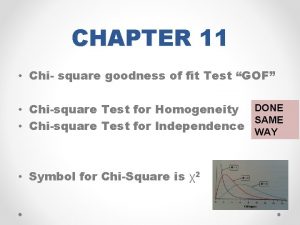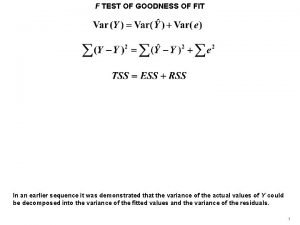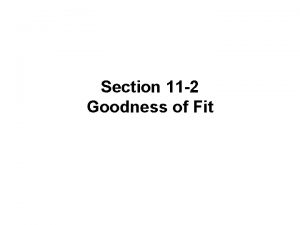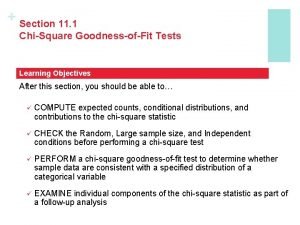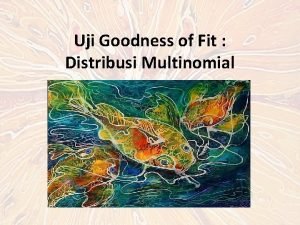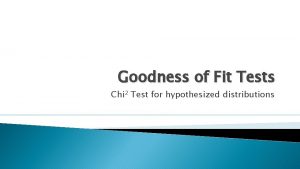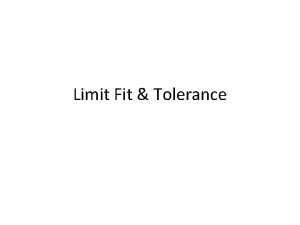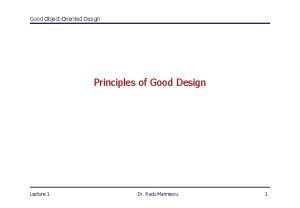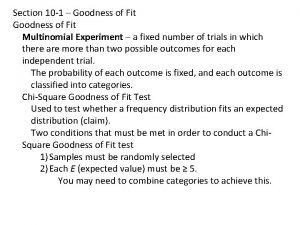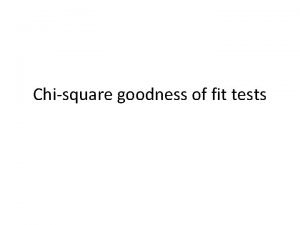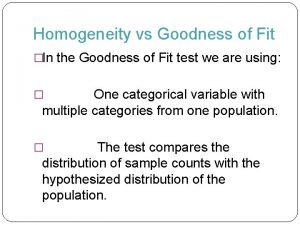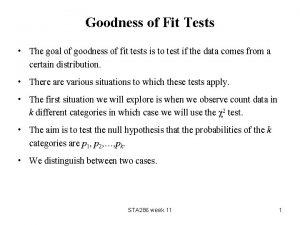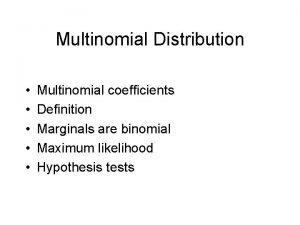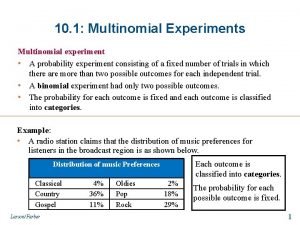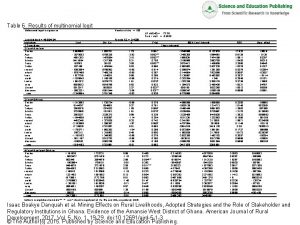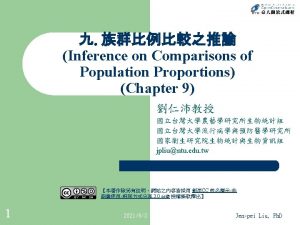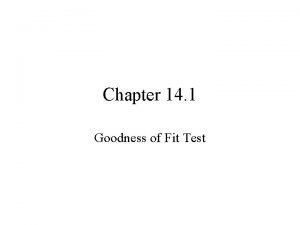Goodness of Fit Test for Proportions of Multinomial




















- Slides: 20

Goodness of Fit Test for Proportions of Multinomial Population • Chi-square distribution • Hypotheses test/Goodness of fit test

Chi-square distribution With 2 degrees of freedom With 5 degrees of freedom With 10 degrees of freedom 0

Chi-Square Distribution • We will use the notation to denote the value for the chi-square distribution that provides an area of to the right of the stated value. • For example, there is a. 95 probability of obtaining a 2 (chi-square) value such that

For 9 d. f. and =. 975 Selected Values from the Chi-Square Distribution Table Our value

. 025 Area in Upper Tail =. 975 2 0 2. 700

For 9 d. f. and =. 025 Selected Values from the Chi-Square Distribution Table Our value

Area in Upper Tail =. 025 2 0 19. 023

For 9 d. f. and =. 10 Selected Values from the Chi-Square Distribution Table Our value

Area in Upper Tail =. 10 2 0 14. 684

• • For 9 d. f. and For 8 d. f. and For 6 d. f. and For 10 d. f. and. 025 =16. 919, =. 05 =3. 49, =. 90 =16. 812, =. 01 =18. 9, = between. 05

Hypothesis (Goodness of Fit) Test for Proportions of a Multinomial Population This is simply a hypothesis test to see if the hypothesized population proportions agree with the observed population proportions from our sample. 1. Set up the null and alternative hypotheses. 2. Select a random sample and record the observed frequency, fi , for each of the k categories. 3. Assuming H 0 is true, compute the expected frequency, ei , in each category by multiplying the category probability by the sample size.

Hypothesis (Goodness of Fit) Test for Proportions of a Multinomial Population 4. Compute the value of the test statistic. where: fi = observed frequency for category i ei = expected frequency for category i k = number of categories Note: The test statistic has a chi-square distribution with k – 1 df provided that the expected frequencies are 5 or more for all categories.

Hypothesis (Goodness of Fit) Test for Proportions of a Multinomial Population 5. Rejection rule: p-value approach: Reject H 0 if p-value < Critical value approach: Reject H 0 if where is the significance level and there are k - 1 degrees of freedom

Multinomial Distribution Goodness of Fit Test • Example: Finger Lakes Homes (A) Finger Lakes Homes manufactures four models of prefabricated homes, a two-story colonial, a log cabin, a split-level, and an A-frame. To help in production planning, management would like to determine if previous customer purchases indicate that there is a preference in the style selected.

Multinomial Distribution Goodness of Fit Test • Example: Finger Lakes Homes (A) The number of homes sold of each model for 100 sales over the past two years is shown below. Split. AModel Colonial Log Level Frame # Sold 30 20 35 15

Multinomial Distribution Goodness of Fit Test n Hypotheses H 0: p. C = p. L = p. S = p. A =. 25 Ha: The population proportions are not p. C =. 25, p. L =. 25, p. S =. 25, and p. A =. 25 where: p. C = population proportion that purchase a colonial p. L = population proportion that purchase a log cabin p. S = population proportion that purchase a split-level p. A = population proportion that purchase an A-frame

Multinomial Distribution Goodness of Fit Test n Rejection Rule Reject H 0 if p-value <. 05 or 2 > 7. 815. With =. 05 and k-1=4 -1=3 degrees of freedom Do Not Reject H 0 7. 815 2

Multinomial Distribution Goodness of Fit Test • Expected Frequencies e 1 =. 25(100) = 25 e 3 =. 25(100) = 25 • Test Statistic =1+1+4+4 = 10 e 2 =. 25(100) = 25 e 4 =. 25(100) = 25

Multinomial Distribution Goodness of Fit Test • Conclusion Using the p-Value Approach Area in Upper Tail c 2 Value (df = 3) . 10. 05. 025. 01. 005 6. 251 7. 815 9. 348 11. 345 12. 838 Because c 2 = 10 is between 9. 348 and 11. 345, the area in the upper tail of the distribution is between. 025 and. 01. The p-value < . We can reject the null hypothesis.

Multinomial Distribution Goodness of Fit Test • Conclusion Using the Critical Value Approach 2 = 10 > 7. 815 We reject, at the. 05 level of significance, the assumption that there is no home style preference.
 Multinomial goodness of fit
Multinomial goodness of fit First fit next fit best fit worst fit
First fit next fit best fit worst fit Chi square test goodness of fit
Chi square test goodness of fit Goodness of fit test
Goodness of fit test Goodness of fit test assumptions
Goodness of fit test assumptions F-test formula
F-test formula Goodness of fit test ti 83
Goodness of fit test ti 83 Memory allocation policy
Memory allocation policy Casinos are required to verify that their games
Casinos are required to verify that their games Chi square goodness of fit p value
Chi square goodness of fit p value Uji goodness of fit adalah
Uji goodness of fit adalah Goodness of fit adalah
Goodness of fit adalah Goodness of fit
Goodness of fit Clearance fit tolerance
Clearance fit tolerance Person-job fit and person-organization fit
Person-job fit and person-organization fit Lord byron writing style
Lord byron writing style Good measurement
Good measurement Goodness of measures
Goodness of measures Good interface design
Good interface design 2 nephi chapter 6
2 nephi chapter 6 Experiments in goodness
Experiments in goodness
